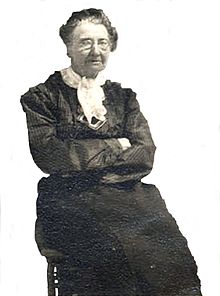Caroline Weldon

Caroline Weldon was a 19th-century artist and activist with the National Indian Defense Association. Weldon became a confidante and the personal secretary to the legendary Lakota Sioux Indian leader Sitting Bull during the time when Plains Indians had adopted the Ghost Dance movement.
Early life and education
Caroline Weldon was born Susanna Carolina Faesch on 4 December 1844 in Kleinhüningen, Canton Basel, Switzerland. Her father was Johann Lukas Faesch, a career Swiss mercenary military officer serving in a Swiss regiment in France; her mother was Anna Maria Barbara, née Marti. She arrived in America in 1852 at the age of 8 years, together with her mother, settling in Brooklyn, Kings County, New York. That year, her mother was remarried to the exiled German revolutionary, Dr. Karl Heinrich Valentiny who ran a medical practice in Brooklyn. In Brooklyn, New York on 30 May 1866 Susanna Carolina Faesch was married to Dr. Bernhard Claudius Schlatter, a physician and fellow Swiss. The marriage ended in divorce a few years later. Thereafter she met, cohabited, and had a son with a man named Weldon who would eventually abandon her.[1]
Career

Weldon pursued her interests in art. After her divorce on 18 July 1883 from Dr. Claude Schlatter and having been abandoned by Weldon, she became committed to the cause of Native Americans. In the summer of 1889 Caroline Weldon traveled to Dakota Territory to fulfill her dream of living among the Sioux. She had joined NIDA, the National Indian Defense Association, headed by Dr. Thomas Bland and his wife Cora Bland, embarking on a quest to aid the Sioux in their struggle to fight the US government’s attempt under the Dawes Act to expropriate vast portions of the Great Sioux Reservation for the purpose of opening same up for white settlement, with the intent of rendering the creations of the two new states of North Dakota and South Dakota economically viable. She befriended Sitting Bull, leader of the traditionalist faction among the Sioux acting as his secretary, interpreter and advocate. After she had moved to live at Sitting Bull’s compound on the Grand River at Standing Rock Indian Reservation with her young son Christy, her confrontations and open defiance of Indian Agent James McLaughlin did not endear her to the general public, causing the latter to initiate a smear campaign, resulting in her being hated and reviled by much of the white community and vilified in the national press. When in summer of 1890, the Ghost Dance Movement swept through the Indian Reservations of the West; she denounced it and warned Sitting Bull that it would give the government an excuse to harm him and summon the military for intervention against his people that would result in the destruction of the Sioux Nation. Sitting Bull turned against her and upon her son Christy falling ill in November of that year, she decided to leave. The subsequent events of Sitting Bull’s murder and the Wounded Knee Massacre the following December proved her right, adding to her sense of futility and failure. Her son Christy died on the 19th of November 1890 near Pierre on the riverboat Chaska while on her way to her new home in Kansas City, MO. She lived briefly in the latter city with her nephew Friedrich William Schleicher, a school teacher, only to return eventually to Brooklyn, NY. She disappeared into obscurity soon after.[2][3][4][5][6][7]
Weldon also painted four portraits of the chief. One is now held by the North Dakota Historical Society.
Later life

Weldon died alone in her Brooklyn apartment on 15 March 1921. The cause of death was accidental third degree burns from a candle to her face and body. She was interred at the Valentiny family plot at Green Wood Cemetery in Brooklyn, NY - Lot 13387, Section 41.[8]
In popular culture
The poet and playwright Derek Walcott refers to Weldon and her life in his play The Ghost Dance and in his epic poem Omeros. He features Native American history together with that of the demise of the Native Arawak people in St. Lucia, in the Caribbean.
The upcoming film Woman Walks Ahead, starring Jessica Chastain and directed by Susanna White, chronicles Weldon's life among the Sioux.
References
- ^ Caroline Weldon genealogy http://worldconnect.rootsweb.ancestry.com/cgi-bin/igm.cgi?op=GET&db=caroline_weldon&id=I03
- ^ Pollack, Eileen. Woman Walking Ahead: In Search of Catherine Weldon and Sitting Bull. Albuquerque: University of New Mexico Press, 2002
- ^ Richardson, Heather Cox. Wounded Knee: Party Politics and the Road to an American Massacre. New York: Basic Books, 2010
- ^ McLaughlin, James. 1910. My Friend the Indian http://babel.hathitrust.org/cgi/pt?id=loc.ark:/13960/t00008872;view=1up;seq=11
- ^ Matteoni, Norman E. Prairie Man. The Struggle between Sitting Bull and Indian Agent James McLaughlin. Guilford CT: 2015
- ^ Stanley Vestal Papers, University of Oklahoma Library Archives, Prof. Walter Stanley Campbell (1877-1957) https://digital.libraries.ou.edu/whc/nam/collection.asp?cID=1224&sID=7
- ^ Vestal, Stanley (aka Campbell, Walter Stanley). New Sources of Indian History 1850-1891, University of Oklahoma Press, Norman, OK, 1934; transcripts of letters written by Caroline Weldon
- ^ Caroline Weldon burial site. http://www.findagrave.com/cgi-bin/fg.cgi?page=gr&GSln=Weldon&GSfn=Susanna&GSbyrel=all&GSdyrel=all&GSob=n&GRid=57225492&df=all&
